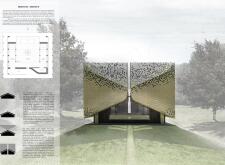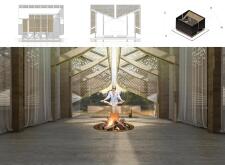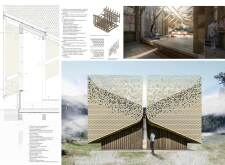5 key facts about this project
The meditation cabin project offers a thoughtful space designed for reflection and mindfulness. Located in a serene environment, the cabin emphasizes the significance of the connection between nature and the individual. It serves both a practical function and a spiritual purpose, making it a place for introspection through the practice of meditation. The design reflects the philosophies of Maori culture, integrating key principles that enhance the user experience.
Conceptual Framework
The foundation of the design is the idea of breathing. This simple act is central to the meditation experience, guiding the spatial layout and interaction within the cabin. Users are invited to focus on their breath—inhale through the nose and exhale through the mouth. This rhythm mirrors the natural cycles of life and encourages a sense of calm. By placing importance on breath, the space contributes to mental clarity and relaxation.
Spatial Organization
Inside the cabin, there are three distinct areas: the meditation platform, corridor, and prominent cornice. Each space represents a phase of meditation: dharana, dhyana, and samadhi. The arrangement supports a journey toward deeper awareness, allowing users to engage fully with their thoughts and feelings. A covered entrance leads into a corridor that encompasses a slightly elevated platform, guiding individuals in their approach to meditation.
Cultural Elements and Materiality
The design respects Maori culture, integrating significant symbols throughout the structure. Pillar posts serve both as structural supports and as links between PAPATUANKU (Mother Earth) and RANGINUI (Father Sky). This dual role adds depth to the cabin, connecting physical form to spiritual meaning. The facade features patterns inspired by traditional Maori art, designed to dissolve visually similar to fleeting thoughts during meditation. Materials such as glue-laminated beams and cross-laminated timber provide essential stability while ensuring that the connection to local building traditions remains evident.
Details of Transition
The porch, known as paepae, acts as a crucial threshold. It marks the place where one moves from the external world into a more private space of peace. This transition is essential for aligning with the meditation practice. The architecture invites users to pause at this boundary, allowing them to leave distractions behind. Through its careful design details, the cabin encourages a proper reflection on the relationship between land, self, and the cycles of life, all within a respectful homage to cultural heritage.






















































